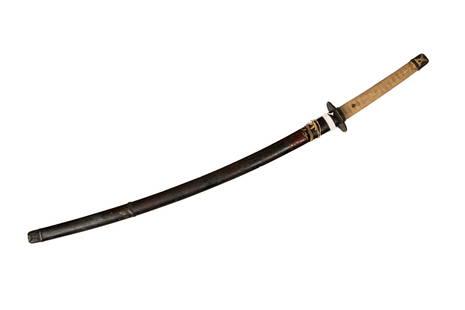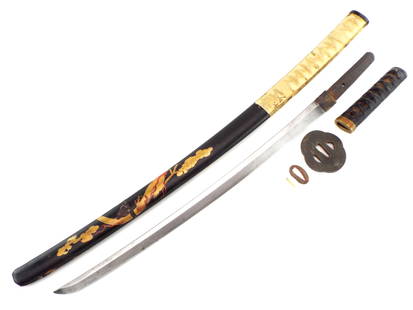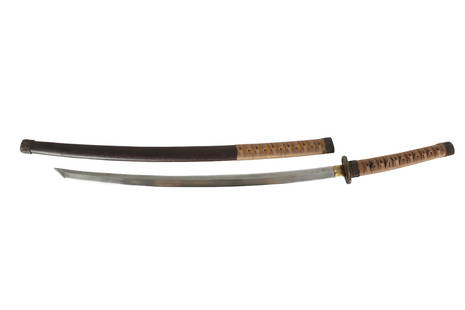
Signed 1650s Japanese Edo Wakizashi by Bishu Osafune
Similar Sale History
View More Items in Weapons & ArmorRelated Weapons & Armor
More Items in Edo Weapons & Armor
View MoreRecommended Collectibles
View More







Item Details
Description
East Asia, Japan, early Edo Period, ca. mid-17th century, signed "Bishu Osafune" on tang. A forged steel wakizashi blade of elegant shinogi-zukuri form bearing a diamond-shaped (iori-mune) profile and the signature of swordsmith Bishu Osafune on one side of the tang. The wavy temper line (gunome-choji) is formed by the tight hammer-folded graining (itame-hada) and bears an attractive tobiyaki pattern with deep tempering at the point. The handle (tsuka) is fitted with stingray skin (samegawa), avian-form ornaments (menuki) shaped from shakudo, and a shakudo-inlaid iron cap. The circular iron hand guard (marugata tsuba) features intricate openwork decorations (sukashi) as well as pairs of kanji - the top pair translates to "bravery" and the bottom pair to "decisiveness." The scabbard (saya) is covered in black lacquer (urushi) and bound with a modern cotton strap. Size (w/ scabbard): 3" W x 28.5" H (7.6 cm x 72.4 cm); (blade): 20.125" L x 1.125" W (51.1 cm x 2.9 cm)
This traditional Japanese sword was both a weapon and a symbol of authority and social status. The wakizashi paired with the longer katana sword marked the wearer as a samurai. The shorter sword was seen as an auxiliary weapon, also used for fighting in close quarters. Wakizashi could also be worn by non-samurai if worn alone, and members of the merchant class (chonin) wore them because of the frequency of encountering bandits when traveling between Japan's cities.
Over the centuries that katana and wakizashi were made, the process of their manufacture became heavily regulated. For example, in 1683, the Tokugawa Shogunate made laws concerning the maximum size of katana and wakizashi. Meanwhile, once a samurai took ownership of his new weapon, he had to wear it in a highly regulated manner. Wakizashi and katana in this period were both deadly weapons and signs of prestige. The craftsmanship of this piece is evident and reflects hundreds of hours of work.
Provenance: private Jones collection, Boulder, Colorado, USA; ex-private Sacramento, California, USA collection
All items legal to buy/sell under U.S. Statute covering cultural patrimony Code 2600, CHAPTER 14, and are guaranteed to be as described or your money back.
A Certificate of Authenticity will accompany all winning bids.
We ship worldwide to most countries and handle all shipping in-house for your convenience.
#175625
This traditional Japanese sword was both a weapon and a symbol of authority and social status. The wakizashi paired with the longer katana sword marked the wearer as a samurai. The shorter sword was seen as an auxiliary weapon, also used for fighting in close quarters. Wakizashi could also be worn by non-samurai if worn alone, and members of the merchant class (chonin) wore them because of the frequency of encountering bandits when traveling between Japan's cities.
Over the centuries that katana and wakizashi were made, the process of their manufacture became heavily regulated. For example, in 1683, the Tokugawa Shogunate made laws concerning the maximum size of katana and wakizashi. Meanwhile, once a samurai took ownership of his new weapon, he had to wear it in a highly regulated manner. Wakizashi and katana in this period were both deadly weapons and signs of prestige. The craftsmanship of this piece is evident and reflects hundreds of hours of work.
Provenance: private Jones collection, Boulder, Colorado, USA; ex-private Sacramento, California, USA collection
All items legal to buy/sell under U.S. Statute covering cultural patrimony Code 2600, CHAPTER 14, and are guaranteed to be as described or your money back.
A Certificate of Authenticity will accompany all winning bids.
We ship worldwide to most countries and handle all shipping in-house for your convenience.
#175625
Condition
Scabbard is perhaps a later replacement, and knotted cotton cord is modern. Minor abrasions to blade, handle, hand guard, and scabbard, with minor wear to handle bindings and shakudo cap inlays, otherwise in excellent condition. Modern fabric carrying case included.
Buyer's Premium
- 26.5%
Signed 1650s Japanese Edo Wakizashi by Bishu Osafune
Estimate $3,000 - $4,500
29 bidders are watching this item.
Shipping & Pickup Options
Item located in Louisville, CO, usSee Policy for Shipping
Payment

TOP




























































![George Washington Signed Discharge: Partly printed discharge document signed by George Washington, as Commander in Chief of the Armies of the United States. Newburgh, [New York], 4 January 1783. 1 page, ## x ## in. Undersigned by Washin](https://p1.liveauctioneers.com/7226/322253/173251475_1_x.jpg?height=310&quality=70&version=1710004847)
![[Ambrotype] Texas Confederate Soldier: Sixth plate ambrotype. Full leatherette case. Portrait of a possible Texas Confederate soldier. A silver star device was used to pin up the brim of his light-toned headgear, a look often seen in image](https://p1.liveauctioneers.com/7226/322253/173251509_1_x.jpg?height=310&quality=70&version=1710004847)


![Captured Bowie Knife w/ Period Note of Provenance: Captured Confederate D-hilt Bowie knife. [Kenansville, North Carolina]: [Louis Froelich factory]. With original metal and leather sheath with affixed period notes. First note with only remnants. Secon](https://p1.liveauctioneers.com/7226/325455/175169154_1_x.jpg?height=310&quality=70&version=1712370394)

![[Civil War] Bullet Which Nearly Killed Soldier: Lead bullet encased in gold acorn fob with chain. Finely engraved: "W.D. Fiske / 14th Regt. C V / Fredericksburg / Dec 17, 1863." Acorn approx. 1 1/2 x 1 in. Overall length 6 1/2 in. Published in "Her](https://p1.liveauctioneers.com/7226/325455/175169103_1_x.jpg?height=310&quality=70&version=1712370394)